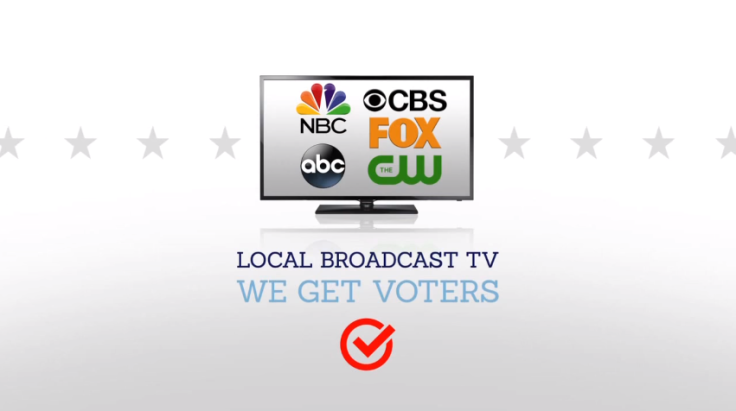TV Stations Are Officially Freaked Out About The Rise Of Digital Political Ads

Television broadcasters are officially spooked about the rise of digital advertising, and if you’re looking for proof, all you have to do is turn on your TV. The Television Bureau of Advertising (TVB), a trade association that represents local broadcast television stations across the United States, launched its very first television ad campaign Wednesday promoting the effectiveness and power of TV ads in political campaigns.
“There's a lot of shiny new objects out there now, especially digital shiny new objects,” said Steve Lanzano, CEO of TVB. “We have to get our value proposition out there.”
The campaign, called We Get Voters, will run initially on stations in and around Washington, D.C., before expanding to primary states like New Hampshire and South Carolina and, ultimately, a national run. In addition to the spots, TVB will hold a number of events along the campaign trail, including receptions following the forthcoming GOP debate in Las Vegas and at both the Republican and Democratic national conventions.
“Local broadcast TV wins elections,” Lanzano said. “It's our job to remind people in the political arena of this fact.”
Television stations already get the lion’s share of advertising budgets from campaigns and special interest groups. More than 51 percent of the $11.4 billion that will be spent on ads during the 2016 elections will go to TV, according to Borrell Associates.
But TVB and its member stations haven’t launched this campaign to expand their lead. They launched it to protect themselves from a coming tsunami of digital ad spending, which has grown from a rounding error on politicians' budgets into a serious contender for ad dollars in very short order. Just over $1 billion will be spent on digital ads in 2016, a nearly ten-fold increase from the $159 million spent in 2012, and that growth is just the beginning. By 2020, Borrell projects that total will grow to $3.3 billion, putting it neck and neck with broadcast television.
The Razor's Edge
For decades, television was attractive to advertisers because it offered the nicest looking, most effective advertising format at the largest possible scale. Digital appeals because it offers the ability to identify and target extremely specific swaths of the population instead. For the right price, a campaign, super PAC or special interest group can send campaign or candidate-centric ads to people in a wide variety of ways: on their computers, phones, televisions, in real time and sometimes even when they enter a specific physical space or location.
Those techniques have been available in the advertising world for years. But where a typical shopper might be disturbed by getting a salad dressing ad on her smartphone within seconds of entering a grocery store, a certain kind of voter might be excited to get the right kind of ad within seconds of exiting a campaign rally.
"The more relevant you can make an ad to a user, the less that creep factor comes into play," said Katelyn Duff, the chief revenue officer of Division-D, an advertising network that’s been running digital political campaigns for the past six years.
The industry’s technology has gotten so precise, Duff said, that it is possible to send a specific advertisement to one specific person. “I don't see many instances where it would make that much sense, but we been asked to do it in the past, and we have done it,” Duff said.
The Old Standby
The political ad industry has been relatively slow to embrace innovation because it has had little incentive to. Older voters, who tend to vote more than younger ones, are stuck in their ways. They watch a lot of television and spend a lot less time looking at smartphones. According to Lanzano, the average American voter aged 35 and older watches upward of five hours of television every day, and spends just 20 minutes watching web videos.
They also spend an awfully long time talking about it. “The word of mouth of all other media combined doesn't match what television can deliver,” Lanzano said.
That dominance is expected to erode a bit. Research from the media agency Zenith Optimedia found that the only form of media consumption projected to increase over the next five years is digital media. Television, along with all other media types, is projected to decrease, though at a rate of just two percent per year.
And as the demographics continue their shift, Lanzano said the goal of this campaign is not to go to war with digital advertisers. “It's not to say you shouldn’t spend your money there,” Lanzano said. “It's not an 'or.' It's an 'and.'”
© Copyright IBTimes 2024. All rights reserved.





















